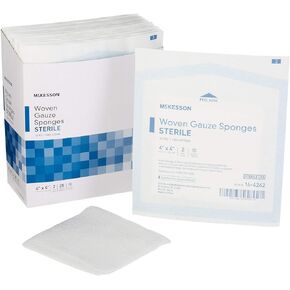- Shopping, made easy.
- /
- Get the app!
Hydrocolloid: primary or secondary dressing for wounds with light to moderate exudate. Helps maintain a moist wound environment to assist in autolytic debridement. When in contact with wound exudate, it forms a fluid/gel environment over the wound bed. Dressing does not break down or leave residue in the wound. Thin and film back versions feature a smooth, tapered design to help minimize friction and prevent dressing edges from rolling up. Thin Hydrocolloid is semi-transparent, allowing visualization of the wound. Contains a semi-transparent layer that permits wound evaluation without removing dressing. Moisture-resistant backing helps prevent urine, feces or moisture from penetrating the dressing to reduce risk of contamination.
 -23%
McKesson Unna Boot with Zinc Oxide and Calamine, Non-Sterile, 4 in x 10 yd, 1 Roll
KWD 5
-23%
McKesson Unna Boot with Zinc Oxide and Calamine, Non-Sterile, 4 in x 10 yd, 1 Roll
KWD 5
 McKesson Woven Gauze Sponges, Sterile, 12-Ply, 100% Cotton, 4 in x 4 in, 2 Per Pack, 25 Packs, 50 Total
KWD 4.500
McKesson Woven Gauze Sponges, Sterile, 12-Ply, 100% Cotton, 4 in x 4 in, 2 Per Pack, 25 Packs, 50 Total
KWD 4.500
 McKesson 8-Ply Sterile Gauze Sponges, 2" x 2", 2 Counts per Pack, 50 Packs (Total 100 Sterile Gauze Sponges)
KWD 3
McKesson 8-Ply Sterile Gauze Sponges, 2" x 2", 2 Counts per Pack, 50 Packs (Total 100 Sterile Gauze Sponges)
KWD 3
 -15%
McKesson Transparent Film Dressing, Sterile, Frame Delivery, 4 in x 4 3/4 in, 50 Count, 1 Pack
KWD 8.500
-15%
McKesson Transparent Film Dressing, Sterile, Frame Delivery, 4 in x 4 3/4 in, 50 Count, 1 Pack
KWD 8.500